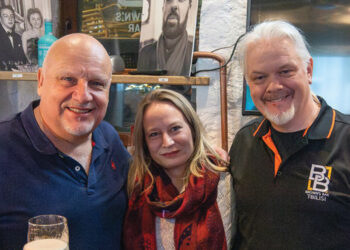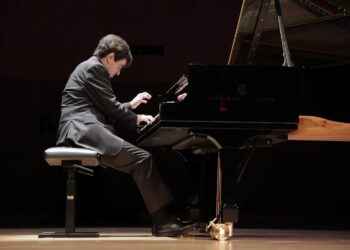The Rustaveli National Theater’s Small Stage became a portal to another world on November 1, where renowned Venetian cellist Davide Amadio and the Georgian Sinfonietta unveiled the timeless elegance of Venetian Baroque music. This concert, titled ‘Venetian Baroque’, opened the 10th Tbilisi Baroque Festival, a milestone event supported by the Italian Embassy and the Shota Rustaveli State Drama Theater.
Presented on period instruments, this evening showcased music by some of the Venetian masters; Albinoni, Platti, Galuppi, Vivaldi, Tartini, and Marcello, imbuing the Tbilisi air with echoes from the canals of Venice.
Unfolding Venetian Elegance: A Thoughtful Program
Venetian Baroque music, with its refined expressiveness and meticulous structuring, captures a world of contrasts: the grandeur of Venice’s opulence, tempered by its contemplative introspection. This curated concert offered a journey through the most evocative works of the era, beginning with Albinoni’s Sinfonie a Cinque, and concluding with Vivaldi’s stirring Cello Concerto in D minor. The program traced an arc from restrained lyricism to more dramatic gestures, each piece selected to reveal the nuanced world of Venetian Baroque.
Opening with Tomaso Albinoni’s Sinfonie a Cinque provided a smooth entry point, gently inviting the audience into the stylistic contours of the evening. The piece’s transparent harmonies set the stage, allowing the following compositions, particularly Platti’s Cello Concerto in D major, to delve deeper into the emotional core of the Baroque repertoire. The carefully chosen pieces not only displayed Venetian musical aesthetics, but also built a balanced narrative that shifted from lively orchestration to the more introspective tones of Tartini and Marcello.
Davide Amadio: A Study in Artistry and Charisma
Davide Amadio’s appearance was perhaps the evening’s defining element, bringing a unique artistic gravity to the Tbilisi stage. Amadio’s reputation as a cellist extends from his technical precision to a deeply nuanced interpretation, and both were in full force during this performance. His rendition of Platti’s Cello Concerto in D major offered a subtle balance of strength and lyricism, particularly evident in the Allegro sections, where he conveyed both lightness and intensity. In the Adagio, Amadio’s playing seemed almost confessional, capturing an intimacy that reflects the introspective tendencies within Baroque music’s grandeur.
Amadio’s interpretations of Vivaldi’s Cello Concerto in C major and D minor were equally telling. The rapid passages of the C major Concerto’s Allegro illustrated his agility and control, a contrast to the restrained beauty he brought to the Andante movement of the D minor Concerto. Here, Amadio uncovered Vivaldi’s talent for integrating lyrical fragility with structural complexity, reminding the audience of Baroque’s layered subtlety. His performance went beyond virtuosity; it seemed to reanimate the historical and emotional landscape of Venetian music itself.
Georgian Sinfonietta: A Refined Ensemble with Interpretative Depth
Amadio’s performance would not have reached its full resonance without the Georgian Sinfonietta’s supportive, refined accompaniment. As Tbilisi’s premier chamber orchestra, the Sinfonietta’s engagement with Baroque repertoire is characterized by attentiveness and clarity, qualities that were essential for this concert’s success. Accompanied by Giorgi Kuzanashvili, who alternated between theorbo and Baroque guitar, the ensemble navigated the concert’s transitions, from the buoyancy of Albinoni’s Sinfonie a cinque to the solemnity of Tartini’s Cello Concerto in A major, with a unified yet dynamically responsive approach.
The Sinfonietta’s collaboration with Amadio found its most compelling expression in Galuppi’s Concerto a Quattro in c minor, a piece that shifts between a sober Grave and an animated Allegro. In the Georgian Sinfonietta’s hands, Galuppi’s characteristic balance between shadow and light was fully articulated, their precise handling of rhythmic patterns enhancing the harmonic tensions at the heart of the piece. The orchestra’s work in Marcello’s Concerto Grosso in e minor provided another example of interpretative insight, with the ensemble’s restrained handling of the Minuetto underscoring Marcello’s intent to contrast joy and solemnity.
Period Instruments: A Window into Baroque Soundscapes
The choice of period instruments for the concert lent the evening an added dimension, layering the performance with the rich textures of historical sound. The natural resonance of gut strings, softer attack of Baroque bows, and tempered tuning enhanced the nuanced tonal world of Venetian Baroque. This approach was most evident in the lower-register passages, where the orchestral strings—tuned in historical pitch—echoed with a warmth and depth modern instruments often miss. Amadio’s cello in particular offered a more vocal quality, its sound fluctuating between mellow softness and intense vibrato, further intensifying the pieces’ emotional range.
This authenticity was especially effective in Marcello’s Concerto Grosso in e minor, where the Sinfonietta’s interplay of timbre and texture amplified the work’s layered counterpoint. The historical tuning and period technique brought out an organic quality in the harmonic shifts, allowing the orchestra to maintain Marcello’s intricate balance between power and finesse. This use of historical instrumentation was not a mere nod to tradition; it was a meticulously calculated choice that connected modern listeners with the Baroque era’s authentic soundscapes.
Tbilisi as a Cultural Crossroads: Reflections on a Decade of Baroque in Tbilisi
This concert wasn’t only about the music; it was a cultural bridge, linking Georgian and Italian musical heritage. By inviting Venetian musicians to showcase the city’s Baroque compositions, the Tbilisi Baroque Festival highlighted Tbilisi’s expanding engagement with European early music traditions. With the arrival of acclaimed artists like Jean Rondeau, Andreas Scholl, Sergio Azzolini, and Jordi Savall later in the festival, Tbilisi continues to position itself as an emerging center for historically informed performance; a discipline gaining significant traction in today’s global music community.
Now in its 10th year, the Tbilisi Baroque Festival has grown from a niche interest to a mainstay in the city’s cultural calendar, attracting renowned musicians and dedicated audiences. This anniversary concert, featuring a distinguished performer like Davide Amadio, underscored the festival’s mission to reconnect contemporary listeners with the expressive depth of early music. By embracing Venetian Baroque, the festival reminded Tbilisi audiences of the universality of Baroque’s emotional landscape—a reminder that, regardless of time or place, the themes of longing, introspection, and joy resonate across centuries.
Davide Amadio and the Georgian Sinfonietta offered a contemplative yet powerful evening, embodying Venetian Baroque’s complexity and allure. Through a carefully crafted program and authentic instrumentation, the concert achieved more than technical excellence; it conveyed the multifaceted spirit of an era. Each composition, from the stately elegance of Albinoni to the introspective counterpoints of Marcello, served as an invitation to explore the vast emotional terrain of Venetian music.
In an increasingly digital and fast-paced world, this kind of performance, which celebrates patience, historical authenticity, and nuanced artistry, is more vital than ever. As Tbilisi continues to cultivate its place on the global cultural map, the Tbilisi Baroque Festival stands as both a testament to the city’s rich artistic vision and a celebration of the enduring relevance of Baroque music. This concert, punctuated by Amadio’s introspective virtuosity and the Sinfonietta’s textured playing, set a fitting tone for the festival’s next decade; a future where music transcends both time and borders.
By Ivan Nechaev














